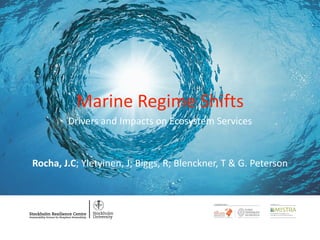
Marine Regime Shifts Causes and Consequences
- 1. Marine Regime Shifts Drivers and Impacts on Ecosystem Services ! ! Rocha, J.C; Yletyinen, J; Biggs, R; Blenckner, T & G. Peterson
- 2. The Anthropocene Social challenge: Understand patters of causes and consequences of regime shifts ! How common they are? Where are they likely to occur? Who will be most affected? What can we do to avoid them? What possible interactions or cascading effects?
- 4. Blenckner T, Niiranen S (2013) Biodiversity - Marine Food-Web Structure, Stability, and Regime Shifts. In: Climate Vulnerability, Understanding and Addressing Threats to Essential Resources (ed. Pielke R), Elsevier, 1570 pp Science challenge: understand phenomena where experimentation is rarely an option, data availability is poor, and time for action a constraint
- 5. to assess co-occurrence patterns of the drivers and ecosystem services consequences that can inform better managerial practices
- 6. Regime Shifts DataBase Established or proposed feedback mechanisms exist that maintain the different regimes = hysteresis ! The shift substantially affect the set of ecosystem services provided by a social-ecological system ! The shift persists on time scale that impacts on people and society
- 7. Mechanism Existence Well established Speculative Contested Contested Speculative Well established Mangroves collapse ! Thermohaline circulation collapse Fisheries collapse ! Marine Eutrophication ! Marine food webs Arctic sea ice Salt marshes to flat tidal Greenland Ice Sheet collapse West Antarctica Ice Sheet Bivalves collapse ! Coral transitions ! Hypoxia ! Kelps transitions ! Sea grass transitions Evidence type ! Models Paleo observation Contemporary observation Experiments Other ! Reversibility ! Irreversible Hysteretic Reversible Unknown
- 8. Methods •Tripartite network and one-mode projections: 13 Regime shifts + 54 Drivers + 26 Ecosystem Services •10 4 random bipartite graphs to explore significance of couplings: mean degree, co- occurrence & clustering coefficient statistics on one-mode projections. Regime shiftsDrivers
- 9. Drivers Network Co−occurrence Index s−squared Density 1.4 1.6 1.8 2.0 02468 Regime Shifts Network Co−occurrence Index s−squared Density 16 20 240.00.10.20.30.4 Average Degree in simulated Drivers Networks Mean Degree Density 23 24 25 26 27 0.00.20.40.60.8 Average Degree in simulated Regime Shifts Networks Mean Degree Density 9 10 11 12 13 0.00.51.01.5 Ecosystem Services Network Co−occurrence Index s−squared Density 1 2 3 4 5 6 7 01234 Regime Shifts Network Co−occurrence Index s−squared Density 22 24 26 0.00.20.40.60.81.0 Average Degree in simulated Ecosystem Services Networks Mean Degree Density 12 16 20 24 0.00.20.40.60.81.01.2 Average Degree in simulated Regime Shifts Networks Mean Degree Density 10 14 18 0.000.020.040.060.080.10
- 10. Agriculture Atmospheric CO2 Deforestation Demand Erosion Fishing Floods Global warming Human population Nutrients inputs Sea level rise Sea surface temperature Sewage Temperature Upwellings Urbanization Arctic sea ice Bivalves collapse Coral transitions Fisheries collapse Hypoxia Kelps transitions Mangroves collapse Marine eutrophication Marine foodwebs Salt marshes Sea grassThermohaline circulation Western Antarctic IceSheet Collapse Food production related drivers, coastal development and climate change are the most important drivers and they co-occur very strongly.
- 11. Soil formation Primary production Nutrient cycling Water cycling Biodiversity Freshwater FoodcropsLivestock Fisheries Wild animal and plant foods Timber Wood fuel Feed, fuel & fiber crops Climate regulation Water purificationWater regulation Regulation of soil erosion Pest and disease regulation Natural hazard regulation Recreation Aesthetic values Knowledge and educational values Spiritual and religious Arctic sea ice Bivalves collapse Coral transitions Fisheries collapse Hypoxia Kelps transitions Mangroves collapse Marine eutrophication Marine foodwebs Salt marshes Sea Grass Termohaline circulation Western Antarctic IceSheet Collapse The most co-occurring ecosystem services are fisheries, biodiversity, nutrient cycling, water purification. Many regime shifts in coastal ecosystems have impacts on aesthetic values and recreation.
- 12. Demand Agriculture Sewage Deforestation Urbanization Globalwarming Fishing Nutrientsinputs Hurricanes Oceanacidification Droughts Infrastructuredevelopment Seasurfacetemperature Aquaculture Irrigationinfrastructure Greenhousegases Tides Surfacemeltingponds Surfacemeltwater Stratosphericozone Oceantemperature(deepwater) Icesurfacemelting Glaciersgrowth Climatevariability(SAM) Glaciers Turbidity Thermalanomaliesinsummer Lowtides Pollutants Flushing Urbanstormwaterrunoff Fishingtechnology Precipitation Invasivespecies Tragedyofthecommons Accesstomarkets Subsidies Foodsupply Waterstratification Impoundments Irrigation AtmosphericCO2 Temperature Sealevelrise Sediments Disease Landscapefragmentation Rainfallvariability Erosion Floods Fertilizersuse Humanpopulation ENSOlikeevents Upwellings Freshwater Feed, fuel & fiber crops Timber Wood fuel Water regulation Foodcrops Livestock Pest and disease regulation Knowledge and educational values Spiritual and religious Water cycling Climate regulation Wild animal and plant foods Soil formation Regulation of soil erosion Natural hazard regulation Aesthetic values Biodiversity Fisheries Water purification Nutrient cycling Primary production Recreation In how many different ways can the drivers impact ecosystem services?
- 13. Bivalves collapse Sea grass Marine eutrophication Fisheries collapse Coral transitions Hypoxia Mangroves collapse Salt marshes Kelps transitions Marine food webs Arctic sea ice Thermohaline circulation WAIS Collapse Local National International Proportion of RS Drivers 0.0 0.2 0.4 0.6 0.8 1.0 WAISCollapse Fisheriescollapse Marinefoodwebs Saltmarshes Arcticseaice Thermohalinecirculation Mangrovescollapse Seagrass Coraltransitions Hypoxia Marineeutrophication Bivalvescollapse Kelpstransitions Human Indirect Activities Biogeochemical Cycle Biodiversity Loss Land Cover Change Climate Biophysical Water 0 2 4 6 8 10 Value 0515 Count A B Climate drivers are common to all regime shifts but don’t co- occur strongly, while strong co-occurrence is found in biophysical, land cover change and biochemical drivers. Managing regime shifts requires multi-level governance, but we can build resilience locally
- 14. Conclusions • Key drivers cluster: food production, climate change and coastal development • Key ecosystem services cluster: cultural services, biodiversity and primary production • Managing marine regime shifts requires coordinated actions across scales • Avoiding regime shifts requires addressing multiple drivers, shared drivers offer strategies for prioritisation and synergistic action.
- 15. Subscribe to our newsletter www.stockholmresilience.su.se/subscribe Thank you!